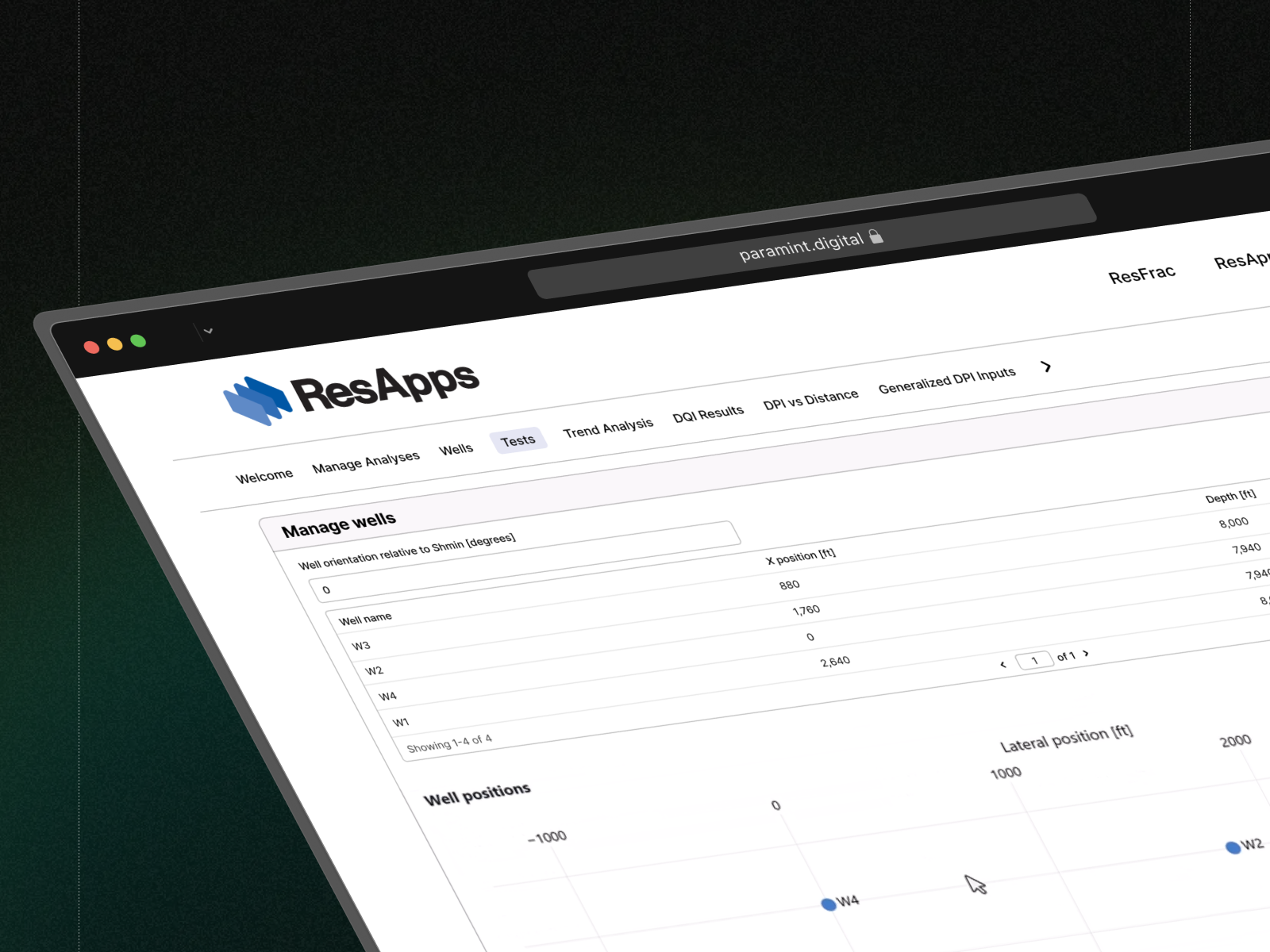Project Overview
ResFrac, an industry leader in fracture simulation and reservoir analysis, sought to expand their digital offerings by creating two cutting-edge web applications—StageOpt and IntTest—to help operators optimize well spacing and stage design. Each tool needed to integrate complex engineering calculations, large file handling, and a modern, user-friendly interface that could be accessed without IT-heavy local installs.
Paramint was engaged to build ResApps—the collective name for StageOpt and IntTest—using Retool, React, HTML/CSS, Azure storage, and custom proprietary APIs for advanced computations. Our team delivered a powerful, web-based platform that automates complex physics modeling while streamlining data input and large file uploads.
Key Challenges
- Complex Physics & Calculations
- StageOpt and IntTest required integrating advanced engineering algorithms developed by ResFrac’s Chief Scientist (e.g., Egor Dontsov’s universal correlation, Devon Quantification of Interference).
- The tools had to accurately model stress shadowing, fracture conductivity, and near-wellbore tortuosity without sacrificing performance or usability.
- Large File Uploads
- ResFrac customers often upload hefty datasets (e.g., CSV logs, reservoir data) exceeding typical upload size limits.
- The need to stream file uploads and store them securely in Azure Blob Storage posed unique architectural constraints.
- Multi-Component Tech Stack
- Required bridging Retool (for rapid app-building) with a React front-end, Azure for storage, and proprietary back-end APIs.
- Ensuring real-time or near-real-time data syncing, error handling, and secure access to these APIs was critical.
- Intuitive, Web-Based UI
- Both StageOpt and IntTest had to be web-accessible to avoid IT overhead from local installations.
- The interface needed to support analysis exports, Monte Carlo simulations, and result visualizations in a way that even non-technical operators could manage.
Solution Approach
- Modular Architecture
- Retool provided the backbone of the user interface for quick layout changes and data binding.
- React was used for custom components and dynamic pages that handle specialized tasks like large file streaming and advanced data visualization.
- Advanced Engineering Calculations via Custom APIs
- Paramint integrated ResFrac’s proprietary scientific methods—including inertial, density, and stress shadow modeling—into API endpoints that StageOpt and IntTest could call.
- Calculations like DQI (Devon Quantification of Interference) and the Chow Pressure Group (CPG) method were exposed as dedicated microservices to keep them maintainable and easily extensible.
- Streaming Large File Uploads
- Implemented a custom large file upload component in Retool/React that chunks and streams data to Azure Blob Storage.
- Azure Data Pipelines automatically ingested these files for further processing, bypassing typical upload size limitations and ensuring reliable data transfers.
- User-Centric Experience
- Provided “one-click” exports from StageOpt into the main ResFrac simulator to continue deeper fracturing and reservoir simulation analysis.
- Built in Monte Carlo uncertainty quantification options, so users could instantly see the effect of variability in perforation phasing or diameter.
- Included built-in help content and simplified workflows to let engineers set up an analysis in minutes—no advanced IT knowledge required.
- Secure, Cloud-Native Deployment
- Hosted the applications in a scalable Azure environment, leveraging Role-Based Access Control (RBAC) for secure data isolation.
- Continuous Integration/Continuous Deployment (CI/CD) pipelines handled automated testing and rollouts, ensuring a stable, always up-to-date user experience.
Technical Implementation Highlights
- Retool + React: Leveraged Retool for quick layout creation, combined with custom React components to handle specialized tasks (e.g., large file streaming, advanced charting).
- Azure Storage: Stored large CSV logs, reservoir data, and analysis outputs with automatic backup and versioning capabilities.
- Proprietary APIs: Integrated advanced algorithms for stage design (StageOpt) and well-to-well interference (IntTest) via secure REST endpoints, enabling robust Monte Carlo analysis and real-time feedback.
- User-Focused UI: Provided intuitive wizards, embedded help content, and easy export features to the ResFrac simulator—allowing diverse technical teams to adopt the tools seamlessly.
Outcomes & Benefits
- Accelerated Well Spacing and Stage Design Analyses
- Engineers can now quickly set up analyses in StageOpt to predict proppant distribution and uniformity index, leading to more efficient fracturing operations and higher ROI.
- Confident Interference Evaluations
- IntTest provides immediate insights into fracture conductivity and potential production interference—empowering teams to optimize well spacing and reduce costly overdrilling.
- Seamless Large File Handling
- The custom streaming solution eliminated file-size constraints and manual splitting. Users can upload multi-GB files in a single go, boosting productivity and data fidelity.
- Improved Collaboration & Data Sharing
- Web-based environment and export/import features made it easier for cross-functional teams to share results, integrate them into larger reservoir simulations, and iterate quickly.
- Reduced IT Overhead
- Because no local install was required, corporate firewalls and software distribution complexities were minimized—allowing customers to onboard with minimal friction.
